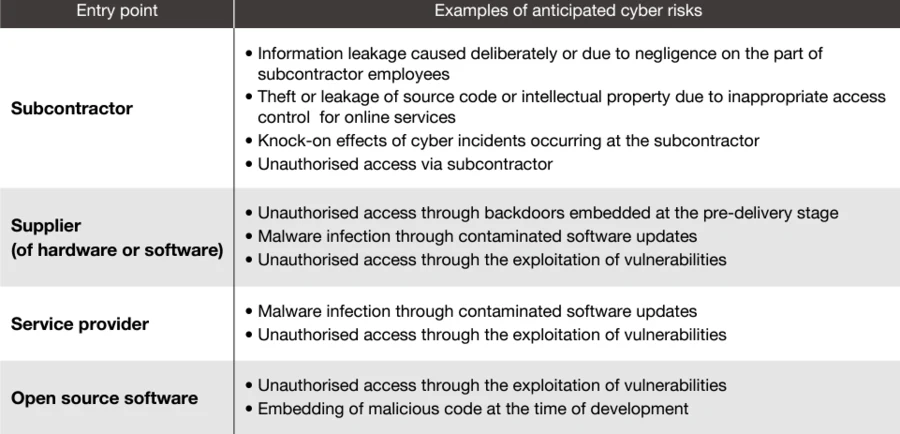| 7 min read
Table of contents
As we’ve seen in our previous blog post, financial institutions have long been a priced target for cyberattacks. And now, an emerging threat has been on the rise: supply chain attacks. These attacks don’t target the financial institution directly, but rather infiltrate its software vendors or other partners within the complex web of suppliers that make up the modern financial ecosystem. Once inside, attackers cause a ripple effect faced by both the affected vendor and the entity using that service. Both companies may experience data breaches, malware installation, operational difficulties and possibly even future regulatory fines A successful supply chain attack can also damage the trust of customers and partners alike.
Last year, the landscape of the threats in the software supply chain showed how the level of sophistication of these attacks is changing, making them more dangerous. In 2023, sophisticated attacks targeting the banking sector were uncovered. In both attacks, threat actors uploaded malicious packages to NPM, the largest software registry in the world. In the first attack, the package included a payload made to secretly intercept login information and send it to a remote address. In the second attack, the packages contained scripts that, upon installation, identified the operating system of the victim and decoded relevant encrypted files from the packages. Afterwards, the files were used to download a malicious binary onto the victim’s system. The threat actor leveraged the Havoc Framework, which is an advanced post-exploitation command and control framework. This framework enables attackers to manage and evade attacks by bypassing the security measures such as Windows Defender. It’s important to mention that the attacker posed as a bank employee with a fake LinkedIn page associated with the bank, which led to security experts researching the incident to consider that the whole situation could be a penetration test. This demonstrates a clever strategy that attackers can use to trick researchers.
These attacks underscore the sophistication in which malicious actors are carrying out their attacks. Methods are evolving to exploit vulnerabilities in the supply chain, making it imperative for security measures to also evolve into a stronger front. We’ll discuss some best practices and recommendations for those involved with protecting financial institutions. But first, let’s remember what a supply chain attack is.
What is a supply chain attack?
A supply chain attack is a kind of cyberattack that targets weak links in an company’s network, exploiting vulnerabilities in vendors and third-party suppliers. Threat actors gain access to these systems and use them to launch attacks on the final target, the financial institution in this case. Supply chain attacks are dangerous because they can be very difficult to detect. Organizations may not even be aware that their vendors have been compromised or they may not even have clear visibility of third-party components in their software.
These attacks target trusted suppliers who provide software or services that are crucial to the organization’s supply chain. This could be a supplier, vendor, a customer or a third-party software library that the company is dependent upon. Attackers can tamper with software during the manufacturing or distribution process. They could target a trusted vendor and gain access through a weakness they find. They can steal credentials of the suppliers, or even track vulnerabilities and seek out the organizations that use the vulnerable vendor.
Why is the financial industry vulnerable to supply chain attacks?
Aside from being a high-value target because of the sensitive information they access and handle, financial institutions are particularly vulnerable. They extensively use third-party services for their online platforms. They also use third-party services for cloud-storage, data processing or other crucial functions. These complex software ecosystems means a greater number of entry points, an expanded attack surface, making supply chain security a critical priority.
Trends and threats
As previously stated, supply chain attacks are becoming more sophisticated and are now targeting new areas with combined tactics. Last year, key trends included:
-
Multi-package attacks: Attackers split malicious actions across multiple packages to evade detection.
-
Commit fraud: Cybercriminals were seen acting like legitimate and well-known sources while introducing their malicious code.
-
Abandoned digital assets: Attackers exploited old assets, like deserted AWS buckets, to introduce malicious code and make them seem like a trusting delivery mechanism.
-
Good old social engineering: Social media was used to establish trust; case (1) fake developer profiles that tricked users into using malicious open-source packages, and case (2) reused Proof of Concepts (PoCs) to create misleading scripts for recently disclosed vulnerabilities.
Software supply chain attacks are not declining in 2024; on the contrary, they’re expected to evolve. This leads to enhanced challenges and risks for companies, specifically the well sought-after financial sector. The threats highlighted by SecurityWeek’s Cyber Insights are the following:
-
State-sponsored attacks that look to destabilize economies
-
Concentration risks within extended supply chains, including reliance on a single supplier or fourth parties
-
Sophisticated supply chain attacks that leverage AI/ML
-
Joint ventures among technically skilled criminal groups to target supply chains
-
Open-source software (OSS) corruption with malicious packages on public repositories
What are supply chain cyber risks?
Due to their complex ecosystems, financial institutions face a diverse range of risks from different entry points. According to a study on trends in supply chain cyber risk management from 2022 to 2023, these are possible cyber risks and their probable entry points:

Taken from the study conducted by PwC.
Supply chain cyber risk management recommendations
Thanks to regulatory authorities, companies are pushed to have guidelines that provide specific conditions they must comply with when using a vendor service. For example, PCI DSS published a document called “Information Supplement: Third-Party Security Assurance”. This document outlines the specific PCI DSS requirements applicable to providers. It provides guidance to both the supplier and the company acquiring the service. It also goes through many controls both companies need to have, like secure access control and network security. A responsible use of vendors is also encouraged by other laws and regulations. The California Consumer Privacy Act (CCPA) and the General Data Protection Regulations (GDPR) among others. These laws mandate companies make sure the suppliers they work with adhere to the applicable regulations.
The following recommendations for software supply chain security came from financial institutions experts around the world. They discuss the stages and the recommendations a person in charge of supply chain security should consider when choosing and dealing with a supplier.
-
Pre-selection stage: security risk pre-screening
- Collect and evaluate data that is openly available to the public in order to conduct security risk assessments on the supplier and its products. Using external risk evaluation services could make this procedure faster.
-
Contracting stage: security risks assessment
- Assign technical/security staff members to the assessment team, and base the evaluation on current threat scenarios.
- Prepare for the possibility of incidents and document the extent of duties and deadlines for reporting such events in a service level agreement.
-
Security risk management with subcontractors
- Examine the risk management procedures of subcontractors who handle high-risk systems in an in-person visit.
- If work is subcontracted to a fourth party, insist that security management be handled by the original subcontractor. Require all parties further in the chain implement security at the same extent as your own company does.
-
Software management
- When new products are installed, software configuration management needs to be performed and closely linked with vulnerability management.
- Utilize software bills of materials (SBOMs) to oversee resources, improve efficiency and security.
- Make use of management tools for open source software to simplify the process of choosing it and identifying dependencies.
-
Hardware management
- Manage assets meticulously, and create a mechanism that makes it possible for firmware updates to happen swiftly.
- Carry out security tests based on threat scenarios.
-
Reporting to senior management
- Write reports in “business” language and base them on how the expenses will affect revenue, client satisfaction, brand loyalty, and reputation.
- Regarding cybersecurity risks report, consider approaches that are risk-based, monetary cost-based, and IT-based to determine the route best suited to your company.
Software supply chain security best practices
Securing the software supply chain is critical for financial institutions to be better prepared and protected against cyber threats.
-
Manage risks from software vendors: Before onboarding with a vendor, ensure they meet your security requirements. Perform a comprehensive assessment of their security posture (e.g., secure development practices, incident responses, access controls, etc.) before installing anything and keep monitoring it afterwards. Within the contractual clauses, require the vendor to meet your specific standards and notify you of any security incidents.
-
Use a software composition analysis (SCA) tool: Manage third-party and open-source components in your software. SCA can identify open-source software vulnerabilities, which helps you to prioritize patching or upgrading vulnerable components before attackers get to exploit them. It can also help with identifying license conflicts and generating SBOMs. The above is offered by Fluid Attacks’ Continuous Hacking with its SCA technique.
-
Create your own software bill of materials (SBOM): Create and keep a detailed SBOM that lists all software components used within your company, including open-source libraries and third-party dependencies. This helps you identify possible vulnerabilities in your supply chain. When developing software, a well-kept SBOM throughout the SDLC helps minimize issues in the future. There are standard SBOM formats, like CycloneDX and SPDX, which helps having high-quality SBOMs. Our platform generates SBOMs using these two standard formats, which show information, dependencies and vulnerabilities coherently. Learn more about Fluid Attacks’ SBOM process here.
-
Secure the SDLC: Integrate security practices, like SBOMs, throughout the entire SDLC, from code development to deployment. Code reviews, vulnerability scanning, penetration testing, and, very importantly, vulnerability remediation are included as security practices.
-
Manage vulnerabilities: Proactively identifying and addressing vulnerabilities can help to significantly reduce the risk of successful attack targeting weaknesses within your development environment, including your third-party software components. Early detection allows you to patch or update vulnerable components promptly. Continuous scans and manual reviews of digital assets can help to find potential vulnerabilities before an attacker does. Vulnerability management also helps improve vendor management (continuous monitoring and scanning help keep the supplier honest). It can also help comply with regulations along with reducing holes in your attack surface. See how you can benefit from Fluid Attacks’ vulnerability management solution.
Hacking continuously for supply chain management
Managing software supply risks can be enhanced by all of the above. But we would suggest going a step further by hacking continuously. Securing your supply chain goes beyond managing vendor risks. Indeed, the software supply chain security approach includes securing proprietary software, infrastructure and more.
Our AppSec solution includes ethical hackers, who think like malicious actors. They know their strategies and use that knowledge to guide you to defend your systems. Our hacking team performs manual testing, working along vulnerability scanning tools (SAST, DAST, SCA and CSPM) and AI to achieve comprehensive examinations that look for weaknesses and potential issues accurately. From there, the hacking team and the tools report back to your team from our platform, which can be integrated into the VS Code IDE with our extension to further streamline the vulnerability management process for your developers.
This proactive approach enables financial entities, and any other industry, to build a robust security posture against supply chain attacks. Continuous security testing through our solution is done from early stages of the SDLC, which provides prompt information on vulnerabilities and you can proactively decide how to proceed. Let us help your company, contact us now.
Table of contents
Share
Recommended blog posts
You might be interested in the following related posts.











